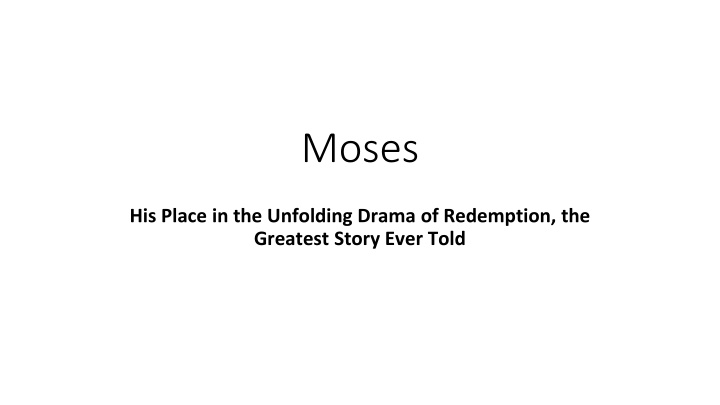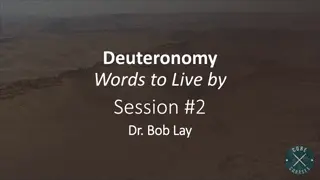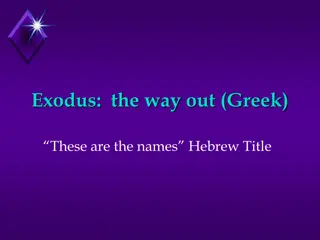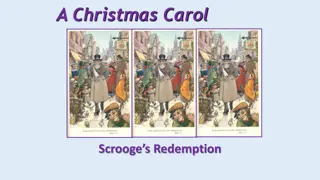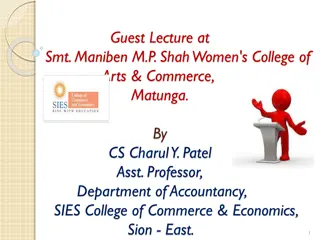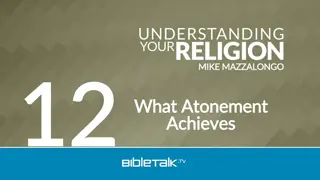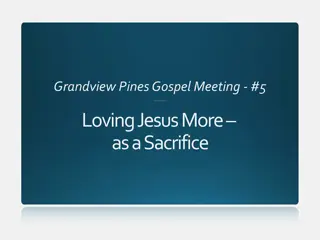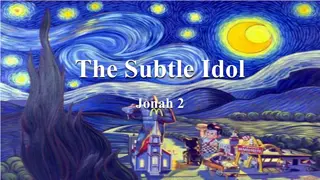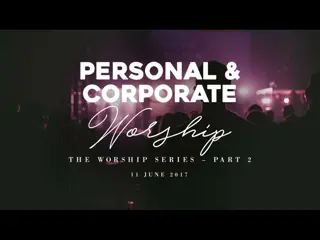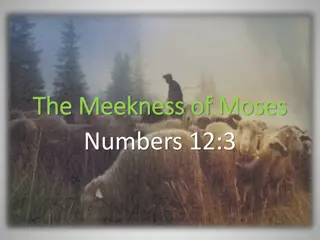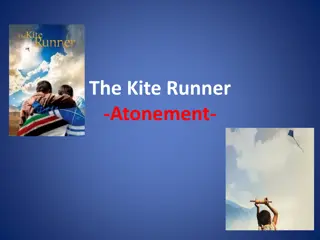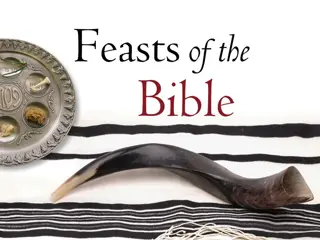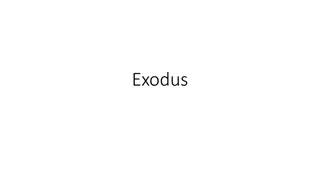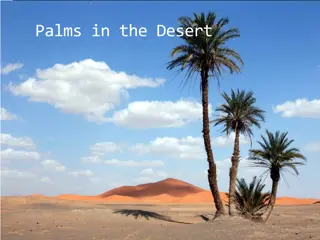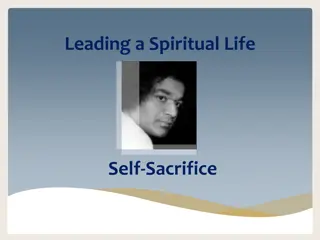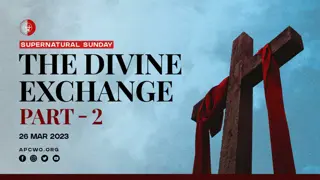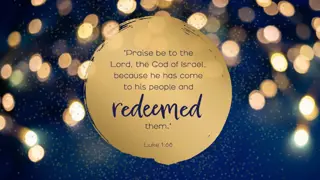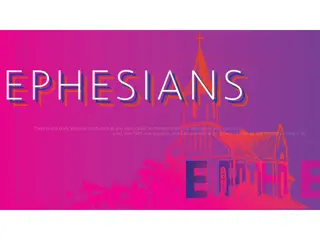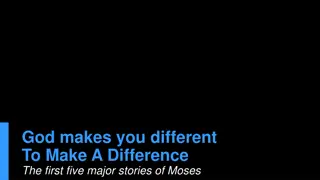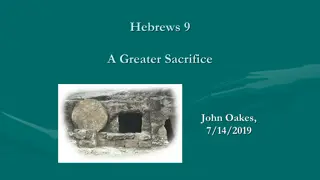Moses - A Journey of Redemption and Sacrifice
Explore the remarkable life of Moses, from his threatened infancy to leading the Exodus and mediating divine instruction. Discover the historical context of Moses in ancient Egypt, his pivotal role in the redemption story, and his journey from Egypt to the edge of the Promised Land. Uncover the parallels between Moses and the Gospel, highlighting themes of sacrifice, atonement, and salvation.
Download Presentation

Please find below an Image/Link to download the presentation.
The content on the website is provided AS IS for your information and personal use only. It may not be sold, licensed, or shared on other websites without obtaining consent from the author.If you encounter any issues during the download, it is possible that the publisher has removed the file from their server.
You are allowed to download the files provided on this website for personal or commercial use, subject to the condition that they are used lawfully. All files are the property of their respective owners.
The content on the website is provided AS IS for your information and personal use only. It may not be sold, licensed, or shared on other websites without obtaining consent from the author.
E N D
Presentation Transcript
Moses His Place in the Unfolding Drama of Redemption, the Greatest Story Ever Told
What a Life! Threatened Infancy and surprising Adoption A person of 2 cultures A murderer A felon in flight A multicultural marriage Leader of Exodus from Egypt Mediator of Divine Instruction at Mt Sinai Leader of 40 year Nomadic Sojourn in the Wilderness Mediates Covenant Renewal between God and Israel on the Plains of Moab Dies with God in Secret & Buried in an Unknown Grave.
Moses & the Gospel All that is accomplished in the death and resurrection of Jesus Christ is portrayed preliminarily in the life of Moses and in the instructions that he mediated to Israel. REDEMPTION SACRIFICE ATONEMENT SALVATION LIFE AFTER DEATH As Moses lifted up the serpent in the wilderness [a story recounted in Numbers 21:4-9], so must the Son of Man be lifted up, that whoever believes in him may have eternal life. Gospel of John 3:14-15 The serpent-entwined cross at right is located on Mount Nebo, Jordan, looking east toward the promised land. This is the traditional site of Moses last day.
Historical Context of Moses Over a period of some 400 years, the descendants of Abraham, Isaac, and Jacob become enslaved in Egypt. From the data given in Scripture, along with extra-biblical texts and archaeological research, the setting of Egyptian slavery is the mid-2nd millennium BCE. The Exodus event and the Wilderness Wandering could have occurred circa 1445- 1400 BCE, during the reign of Thutmose III, or circa 1260-1200 BCE, during the reign of Ramses II (he is the figure depicted at right).
Egypt to the Edge of the Promised Land The land of Goshen is the location of the Israelite community. The exodus event moves east to the Sinai peninsula across the Bitter Lakes (now part of the Suez Canal) or a further south across the Gulf of Suez. There is no consensus on the location of Mt. Sinai (also known as Mt. Horeb). The traditional site is shown here in southern Sinai. Mt Nebo is the end of the wilderness wandering, where Moses views the entrance to the promised land and dies in the hands of God.
Oppression of Israelite Slaves & the Birth of Moses Increasingly hard pressure on the Israelite serving community led inevitably to tensions between it and the Egyptian taskmasters. At one point, it was decreed that Israelite male infants be killed. The Israelite midwives, Shiprah and Puah, did not obey for they feared God more than Pharaoh. After Moses is born, his mother put him in a basket in the Nile River to see if somehow he might be saved. Pharaoh s daughter came to the river bank, saw the infant, recognized him as a Hebrew, but adopted him. His mother was hired as a wet-nurse to nurture Moses. Thus Moses became a person of two cultures. Recall: Herod the Great sent soldiers to kill children in Bethlehem, but Joseph, Mary and Jesus escaped to Egypt, returning sometime after Herod died (Matt 2:13-23)
Murder, Felony Flight, Marriage & Return to Egypt As a young man, Moses witnessed an Egyptian beating a Hebrew, and in anger killed the Egyptian. He fled east to the Sinai/Horeb wilderness. He met some Midianites (also called Cushites) and married Zipporah, the daughter of Jethro, who was a priest. While keeping sheep he encountered a burning bush at the foot of Mount Sinai from which the voice of God commanded him to return to Egypt and to bring the Israelite slaves from Egypt to this mountain, so that they might meet and worship the Lord. Return to Egypt he did, setting up an epic struggle between Pharaoh, the most power individual on the face of the earth, and God, who promised Abraham and Sarah that He would make their descendants a blessing to all the families of the earth (Gen 12:3).
The Struggle Between God and Pharaoh In Exodus 4-15, Moses struggles with Pharaoh to get the slaves released and able to depart Egypt. Early in the encounter between the two men, Moses tells Pharaoh that Israel is God s first-born son (4:22). This metaphor of adoption and family inheritance means that Israel is the heir to God s house and kingdom. The theme of sonship runs through these early chapters, culminating in the death of Egypt s first-born sons. The Hebrews are spared the judgment upon the land of Egypt when the angel of death passes over their homes, since the doorposts of their dwellings have the blood of a lamb applied to them, which covers them from mortal harm.
The Exodus as a Formative Event The Lord brought Israel out of Egypt. In the OT, that event is the most commonly mentioned element in Israel s long history. It bound the Israelites in a common identity and to this day when celebrating Passover, Jews recite we were slaves in Egypt and the Lord brought usout with a mighty hand and outstretched arm. The OT uses several verbs to describe the escape from Egypt, the crossing of the Red Sea, and the drowning of Pharaoh s troops: redeem, deliver, and save, are among those used. Two directional verbs are also used, pointing toward a destination in the land of promise: brought out, and brought up. The OT description of God as the Redeemer is rooted in this community-forming and defining event.
Moses and Leadership Moses was from the tribe of Levi, which was assigned by the Lord to priestly and liturgical duties. He thus officiated at some sacrificial ceremonies, but was not typically designated as a priest. The most common title that he bore was prophet. He is remembered as the person who officiated at the covenant ceremony between Israel and the Lord at Mt Sinai and as the one who mediated divine instruction for the life of the community (Hebrew: Torah; English: Law ). Aaron was Moses s brother and companion in leadership duties. He was the first High Priest. Miriam was Moses sister. She was recognized as a prophet. Moses led Israel by virtue of his calling from the Lord. He was not officially a king. He delegated a variety of leadership roles, including that of Judge, to elders. As in all human community, Moses dealt with criticism and rebellion, moral and spiritual failures among the people and his own family, and was himself also held responsible by the Lord for mistakes.
Moses the Person & His Offices/Roles It is helpful to distinguish between Moses as a person and the roles he played. Moses was a Prophet and there would be a succession of people who would be recognized as following in his footsteps (Deut 18:15-22). Several aspects of Jesus in public ministry are best described as following the pattern of Moses. Moses judged the people of Israel and a succession of people would occupy that societal office, which had both juridical and military aspects. Moses was uniquely a Mediator. This is a role with related parts to it. God spoke uniquely with Moses, who then communicated to the people. Some priestly tasks are mediatorial such as officiating at sacrifice or representing the prayers of the people to God. As a Levite, Moses did these things, plus interceded with God on behalf of the people. As an intercessor and advocate, Moses represented the people to God. His role in providing the laws to the people is also part of the role.
Moses as Mediator: Covenant A covenant is a solemn, recognized relationship between two parties. A covenant is not a negotiated arrangement between peers, but a promise/commitment extended from one party to another. Since most relationships in the ancient world were hierarchical, a covenant was extended by a superior to a party, who was then invited to respond with affirmation and obedience. The details of a covenant might be recorded or otherwise recited in public. A covenant could also be unilateral and unconditional, that is, extended as a binding promise without explicit requirements from the recipient. The first use of the term covenant (Hebrew: berit) in the OT is when God promised Noah and descendants unilaterally not to destroy the world. The sign was a rainbow. God unilaterally promised Abraham land and progeny, and a blessing to the families of the earth through them. Male circumcision was the sign of that covenant. Moses was the mediator of the covenant at Sinai whereby the Lord promised to be Israel s God and Israel promised to be God s people. The analogies to this fundamental declaration are marriage and adoption. The Sabbath Day was the sign of the Sinai Covenant.
Moses as Mediator: The Sinai Covenant The covenant God made with Israel at Mt. Sinai was conditional, requiring Israel s obedience. That is to say, it could be broken. It was not, however, offered as something temporary, as if it would become obsolete or run its course and conclude. You have seen what I did to the Egyptians and how I bore you on eagles wings and brought you to myself.5Now, therefore, if you obey my voice and keep my covenant, you shall be my treasured possession out of all the peoples. Indeed, the whole earth is mine,6but you shall be for me a priestly kingdom and a holy nation (Exodus 19:4-6). The hundreds of individual instructions for the people in the books of Exodus, Leviticus, Numbers and Deuteronomy, are considered Israel s side of the covenant, what it means to be God s holy nation. Religious practices and ethics are a response to God s initiating grace and deliverance. The 10 commandments are a summary and outline of Israel s holy response.
Moses & Jesus at Mt. Sinai A Christian community has lived at the foot of Jebel Musa in the Sinai Peninsula since the 4th century CE. The monastery is named for St. Catherine. The primary church there is the Chapel of the Transfiguration, built during the reign of Justinian in the mid-6th century. It celebrates the connections between the ministry of Moses at Mt. Sinai and that of Jesus with his disciples on the Mount of Transfiguration.
The Divine Light that Reveals & Conceals The burning bush at the foot of Mt. Sinai drew Moses to a divine encounter. A sign of his election. God chose him on behalf of others. When he returned to Sinai with the freed Israelites, there was fire and smoke on the mountain top and Moses approached God to receive instructions. When he returned from this divine encounter, his face shone in reflected glory. Jesus took Peter, James and John to a high mountain in the promised land. There he was transfigured in light before them. Moses and Elijah were there, representing the Law and the Prophets, which bear witness to who Jesus is, and showing that Moses, who did not enter the promised land in his earthly life, would find a place there by virtue of Jesus ministry.
The Apse Over the Iconostasis in the Chapel The Apse has the transfigured Jesus in the center, with Elijah & Moses standing with him, and John, Peter and James awestruck on their knees. There is a gallery of apostles, prophets and saints in small panels literally surrounding the six figures. In the upper left is a panel of Moses removing his sandal before the burning bush. In the upper right is a panel of Moses receiving the 10 Commandments from the Lord.
Moses as Mediator: The Sinai Covenant 2 The covenant God made with Israel at Mt. Sinai was ratified with a sacrificial and committal ceremony (Exod 24:1-8), sealed by blood. The ceremony had four parts, with Moses serving as mediator between God and people. (1) Animals were sacrificed upon an altar and their blood was preserved. (2) Moses poured half of the blood upon the altar. [The altar represents God] (3) Moses read a collection of statutes to the assembled people. They agreed that all that the Lord has spoken, we will do and be obedient. (4) Moses sprinkled the other half of the blood upon the people, saying: See the blood of the covenant that the Lord has made with you. This last act recalls the blood of the Passover lamb in Egypt and foreshadows Jesus taking the cup at the Last Supper and describing it as the new covenant in my blood
From Sinai/Horeb to the Promised Land A major segment of the Torah, often called the Pentateuch, is taken up with the period from the nearly year-long encampment at Mt Sinai through the 39 years of subsequent wilderness wandering to reach the edge of the promised land (Exod 19:1 Deut 34:12), i.e. three and a half of the five books. Narratives are mixed with collections of laws and instructions, and portions of Leviticus and Numbers are among the most difficult for readers to comprehend or to appreciate. The instructions for Israel are traditionally numbered at 613 commandments. They presuppose a tribal, preindustrial, ancient Near Eastern culture. One way to interpret them is to distinguish between what is cultural, ceremonial, and moral/spiritual. This complicated process is already at work in the New Testament, where moral and spiritual purposes from the Torah remain valid, while many cultural and ceremonial practices are not required in the Christian communities. Modern Jews too have developed ways of accommodating the laws for their life of faith.
The End of Moses Life At the end of the wilderness wandering, the Israelite tribes camp on the plains of Moab, where they can look over the Jordan Valley to the West and see the promised land. This is the setting of the book of Deuteronomy, where Moses rehearses God s faithfulness in bringing Israel to this point, reminds and updates the statutes and ordinance, and officiates a covenant renewal with the younger generation about to enter the promised land. Moses himself will not enter the promised land, but dies alone in God s presence and is buried in a secret grave near Mt. Nebo. Through Christ he does enter an eternal inheritance.
